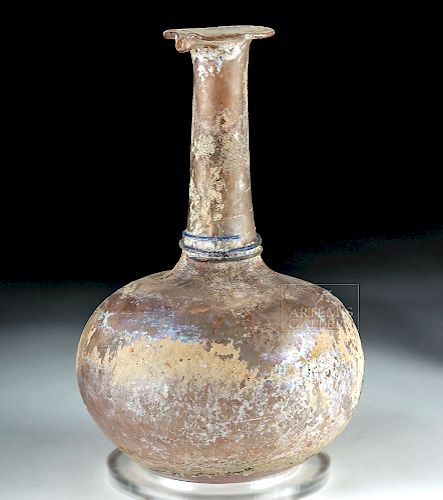Large Roman Glass Flask w/ Spout - Rare Form
Lot 81h
About Seller
Artemis Fine Arts
686 S Taylor Ave, Ste 106
Louisville, CO 80027
United States
Selling antiquities, ancient and ethnographic art online since 1993, Artemis Gallery specializes in Classical Antiquities (Egyptian, Greek, Roman, Near Eastern), Asian, Pre-Columbian, African / Tribal / Oceanographic art. Our extensive inventory includes pottery, stone, metal, wood, glass and textil...Read more
Categories
Estimate:
$1,800 - $2,500
Absentee vs Live bid
Two ways to bid:
- Leave a max absentee bid and the platform will bid on your behalf up to your maximum bid during the live auction.
- Bid live during the auction and your bids will be submitted real-time to the auctioneer.
Bid Increments
| Price | Bid Increment |
|---|---|
| $0 | $25 |
| $300 | $50 |
| $1,000 | $100 |
| $2,000 | $250 |
| $5,000 | $500 |
| $10,000 | $1,000 |
| $20,000 | $2,500 |
| $50,000 | $5,000 |
| $100,000 | $10,000 |
| $200,000 | $20,000 |
About Auction
By Artemis Fine Arts
May 10, 2018
Set Reminder
2018-05-10 10:00:00
2018-05-10 10:00:00
America/New_York
Bidsquare
Bidsquare : Fine Ethnographic / Asian / Ancient Art
https://www.bidsquare.com/auctions/artemis-gallery/fine-ethnographic-asian-ancient-art-3213
Featuring antiquities from around the world including Pre-Columbian, Tribal, Classical, Asian, so much more! Artemis Fine Arts info@artemisgallery.com
Featuring antiquities from around the world including Pre-Columbian, Tribal, Classical, Asian, so much more! Artemis Fine Arts info@artemisgallery.com
- Lot Description
Roman, Imperial Period, ca. 2nd to 3rd century CE. A grand and semi-translucent flask, free-blown from a pale pink glass. The vessel has a concave base with a rough pontil, a rotund spherical body, a rolling shoulder which tapers to a narrow neck line, a cylindrical neck, and a splayed rim with a petite spout. A single azure-hued rigaree trail wraps around the base of the neck, and small chips above indicate this rigaree would have coiled at least twice more around the neck. The flask's muted coral color is nicely complemented with thick areas of silvery and rainbow iridescence in hues of amethyst, sapphire, emerald, citrine, and turquoise. The overall size as well as the pronounced spout make this flask a rare and exquisite example from the ancient Roman Empire! Size: 6" W x 9.75" H (15.2 cm x 24.8 cm).
Ancient glass manufacture had begun in the 2nd millennium BCE in Mesopotamia and Egypt. The Greeks and Phoenicians advanced glass technology greatly in the latter 1st millennium BCE. In the early 1st century CE, Roman workshops began producing blown glass on a large scale. Eventually glass vessels came to replace a wide variety of pottery and metal wares in the ancient world. Ancient Roman glass was traded far beyond the Roman Empire. Roman glass vessels have been found in Scandinavia, India, and in Han Dynasty tombs in China.
Provenance: private East Coast, USA collection
All items legal to buy/sell under U.S. Statute covering cultural patrimony Code 2600, CHAPTER 14, and are guaranteed to be as described or your money back.
A Certificate of Authenticity will accompany all winning bids.
We ship worldwide and handle all shipping in-house for your convenience.
#133183Base of flask is reattached and stabilized with light adhesive residue and earthen material along the break line. Surface wear and abrasions commensurate with age, small nicks to base, body, and rim, with some discoloration, otherwise excellent. Nice earthen deposits as well as incredible silver and rainbow iridescence throughout.Condition
- Shipping Info
-
All shipping is handled in-house for your convenience. Your invoice from Artemis Gallery will include shipping calculation instructions. If in doubt, please inquire BEFORE bidding for estimated shipping costs for individual items.
-
- Buyer's Premium



 EUR
EUR CAD
CAD AUD
AUD GBP
GBP MXN
MXN HKD
HKD CNY
CNY MYR
MYR SEK
SEK SGD
SGD CHF
CHF THB
THB

















